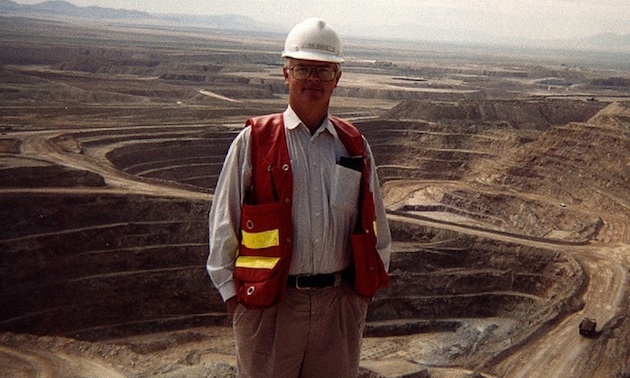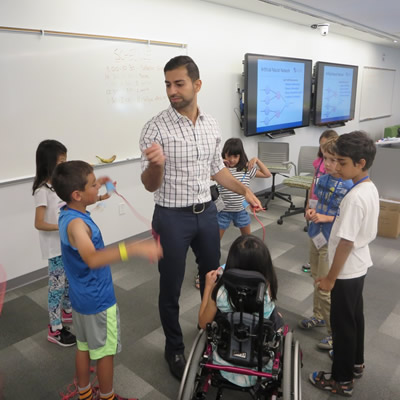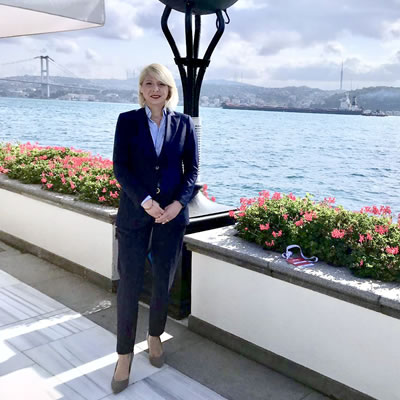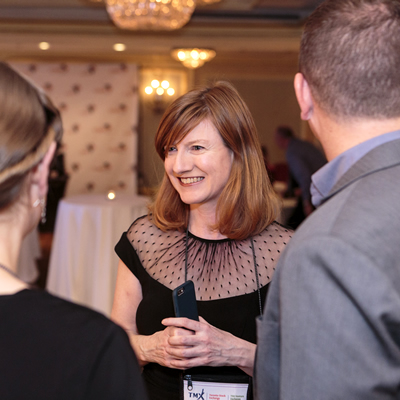Geology brings “a life of endless adventure”
Peter Ogryzlo receives the 2015 H. H. “Spud” Huestis Award for Excellence in Prospecting and Mineral Exploration

Peter Ogryzlo at the Vista Pit mine, Santa Fe Pacific Gold, Nevada. — N. Ogryzlo photo
When asked to make a list of exciting careers, mine geologist wouldn’t make it into most people’s top 10. But for Peter Ogryzlo, recipient of the 2015 H. H. “Spud” Huestis Award for Excellence in Prospecting and Mineral Exploration, being a mine geologist ranks number one.
First, there’s the travel. Ogryzlo, who is now retired, and his wife Christine have lived all over the world.
“We’ve lived in a house on the beach on the Coral Sea,” said Ogryzlo, “skied down the Tasman Glacier in New Zealand and hiked the Himalayas. It’s been a life of endless adventure. You get to see the world in a way others don’t, because you’re not there as a tourist; you’re there as a resident. It gives you a completely different view of the world.”
But the travel is secondary to the the thrill of the chase. The odds of success when prospecting for minerals are extremely low. Ogryzlo estimates that for every 2,000 mineral showings, one might become a mine. Being in on one of those rare discoveries is what makes it all worthwhile.
“When you know you’ve hit it, it’s just astounding,” Ogryzlo said. “You make your way out to the drill shack, maybe on a snowmobile in the middle of the night. Then that core is laid out in the box, and it just sparkles at you. You know you’re the first person to see it. There’s nothing like it.”
How it’s done
One of the key tools geologists use to locate potential ore deposits is induced polarization, which involves sending an electrical current through the earth and then measuring how long it takes to decay. The longer it takes, the more likely it is there’s something in the ground, such as copper, that absorbs an electrical charge. This data is turned into models that help geologists determine where to drill test holes.
But the technology is far from foolproof. Other elements, such as wet clay, can give a false reading. Glacial till and volcanic cover can also mask what lies below. Therefore, although Ogryzlo appreciates such tools, he is adamant that staring at a computer screen does not a good geologist make.
“You can have all the elaborate brain waves you want, but 99 per cent of the time you’re wrong,” he said. “In the industry we talk about the application of field boots to outcrop. There’s nothing like a drill hole for truth. It’s unbeatable. It’s the first test of your theories.”
How it worked at Huckleberry
Such a boots-on-the-ground approach is what earned Ogryzlo this year’s H. H. “Spud” Huestis Award from the Association for Mineral Exploration BC. Named for renowned prospector Herman H. Huestis (1907-1979), the honor is presented annually.
Ogryzlo received the prize in recognition of the key role he played in discovering or developing two additional ore zones at the Huckleberry Copper Mine located near Houston, B.C.
At the time Ogryzlo came on board in 2004, the mine was scheduled to close in 2007. Both management and staff had taken salary concessions just to keep the mine afloat. Ogryzlo’s job was to see if he could extend the mine’s life by locating and proving new ore deposits, a tall order considering he had only three years to do it. This is where his years of work as both an exploration geologist and a mine geologist were put to use.
Drawing on previous research that had located mineralization under the current mine site but which was too deep to access through open pit mining, Ogryzlo suspected that perhaps the deposit could outcrop higher up the mountain. That spring he sent out several prospecting teams, one of which located an outcrop on the first day. Over the next several months, Ogryzlo and his team managed to find and prove enough mineralization to extend the mine’s life to at least 2021. He estimates this amounts to an annual contribution of over $100 million to the local, provincial and national economies.
Despite his success, Ogryzlo is quick to share credit for his discovery with others.
“I spent four years on a deposit that’s been explored for 40 years,” said Ogryzlo. “Dozens of good geologists worked on that project. I was just able to synthesize their work and see something they missed.”
But there’s no question Ogryzlo is delighted with the recognition.
“Having my name and Spud’s used in the same sentence has never happened before,” Ogryzlo said. “Spud was a pioneer, a visionary. To me, that’s the significance of the award. The guys who receive it are legends in the industry.”




